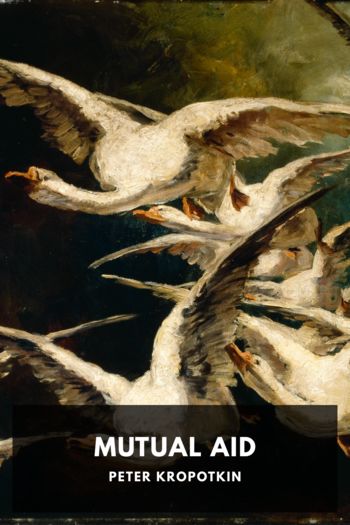Mutual Aid, Peter Kropotkin [fiction novels to read .txt] 📗

- Author: Peter Kropotkin
Book online «Mutual Aid, Peter Kropotkin [fiction novels to read .txt] 📗». Author Peter Kropotkin
I also ought to say a few words at least about the “compound families” of the elephants, their mutual attachment, their deliberate ways in posting sentries, and the feelings of sympathy developed by such a life of close mutual support.45 I might mention the sociable feelings of those disreputable creatures the wild boars, and find a word of praise for their powers of association in the case of an attack by a beast of prey.46 The hippopotamus and the rhinoceros, too, would occupy a place in a work devoted to animal sociability. Several striking pages might be given to the sociability and mutual attachment of the seals and the walruses; and finally, one might mention the most excellent feelings existing among the sociable cetaceans. But I have to say yet a few words about the societies of monkeys, which acquire an additional interest from their being the link which will bring us to the societies of primitive men.
It is hardly needful to say that those mammals, which stand at the very top of the animal world and most approach man by their structure and intelligence, are eminently sociable. Evidently we must be prepared to meet with all varieties of character and habits in so great a division of the animal kingdom which includes hundreds of species. But, all things considered, it must be said that sociability, action in common, mutual protection, and a high development of those feelings which are the necessary outcome of social life, are characteristic of most monkeys and apes. From the smallest species to the biggest ones, sociability is a rule to which we know but a few exceptions. The nocturnal apes prefer isolated life; the capuchins (Cebus capucinus), the monos, and the howling monkeys live but in small families; and the orangutans have never been seen by A. R. Wallace otherwise than either solitary or in very small groups of three or four individuals, while the gorillas seem never to join in bands. But all the remainder of the monkey tribe—the chimpanzees, the sajous, the sakis, the mandrills, the baboons, and so on—are sociable in the highest degree. They live in great bands, and even join with other species than their own. Most of them become quite unhappy when solitary. The cries of distress of each one of the band immediately bring together the whole of the band, and they boldly repulse the attacks of most carnivores and birds of prey. Even eagles do not dare attack them. They plunder our fields always in bands—the old ones taking care for the safety of the commonwealth. The little tee-tees, whose childish sweet faces so much struck Humboldt, embrace and protect one another when it rains, rolling their tails over the necks of their shivering comrades. Several species display the greatest solicitude for their wounded, and do not abandon a wounded comrade during a retreat till they have ascertained that it is dead and that they are helpless to restore it to life. Thus James Forbes narrated in his Oriental Memoirs a fact of such resistance in reclaiming from his hunting party the dead body of a female monkey that one fully understands why “the witnesses of this extraordinary scene resolved never again to fire at one of the monkey race.”47 In some species several individuals will combine to overturn a stone in order to search for ants’ eggs under it. The hamadryas not only post sentries, but have been seen making a chain for the transmission of the spoil to a safe place; and their courage is well known. Brehm’s description of the regular fight which his caravan had to sustain before the hamadryas would let it resume its journey in the valley of the Mensa, in Abyssinia, has become classical.48 The playfulness of the tailed apes and the mutual attachment which reigns in the families of chimpanzees also are familiar to the general reader. And if we find among the highest apes two species, the orangutan and the gorilla, which are not sociable, we must remember that both—limited as they are to very small areas, the one in the heart of Africa, and the other in the two islands of Borneo and Sumatra—have all the appearance of being the last remnants of formerly much more numerous species. The gorilla at least seems to have been sociable in olden times, if the apes mentioned in the Periplus really were gorillas.
We thus see, even from the above brief review, that life in societies is no exception in the animal world; it is the rule, the law of Nature, and it reaches its fullest development with the higher vertebrates. Those species which live solitary, or in small families only, are relatively few, and their numbers are limited. Nay, it appears very probable that, apart from a few exceptions, those birds and mammals which are not gregarious now, were living in societies before man multiplied on the earth and waged a permanent war against them, or destroyed the sources from which they formerly derived food. “On ne s’associe pas pour mourir,” was the sound remark of Espinas; and Houzeau, who knew the animal world of some parts of America when it was not yet affected by man, wrote to the same effect.
Association is found in the animal world at all degrees of evolution; and, according to the grand idea of Herbert Spencer, so brilliantly developed in Perrier’s Colonies Animales, colonies are at the very origin of evolution in the animal kingdom. But, in proportion as we ascend the scale of evolution, we see association growing more and more conscious. It loses its purely physical character, it ceases to be simply instinctive, it becomes reasoned. With the higher vertebrates it is periodical, or is resorted to for the satisfaction of a given want—propagation of the species, migration, hunting, or mutual defence. It even becomes occasional, when





Comments (0)